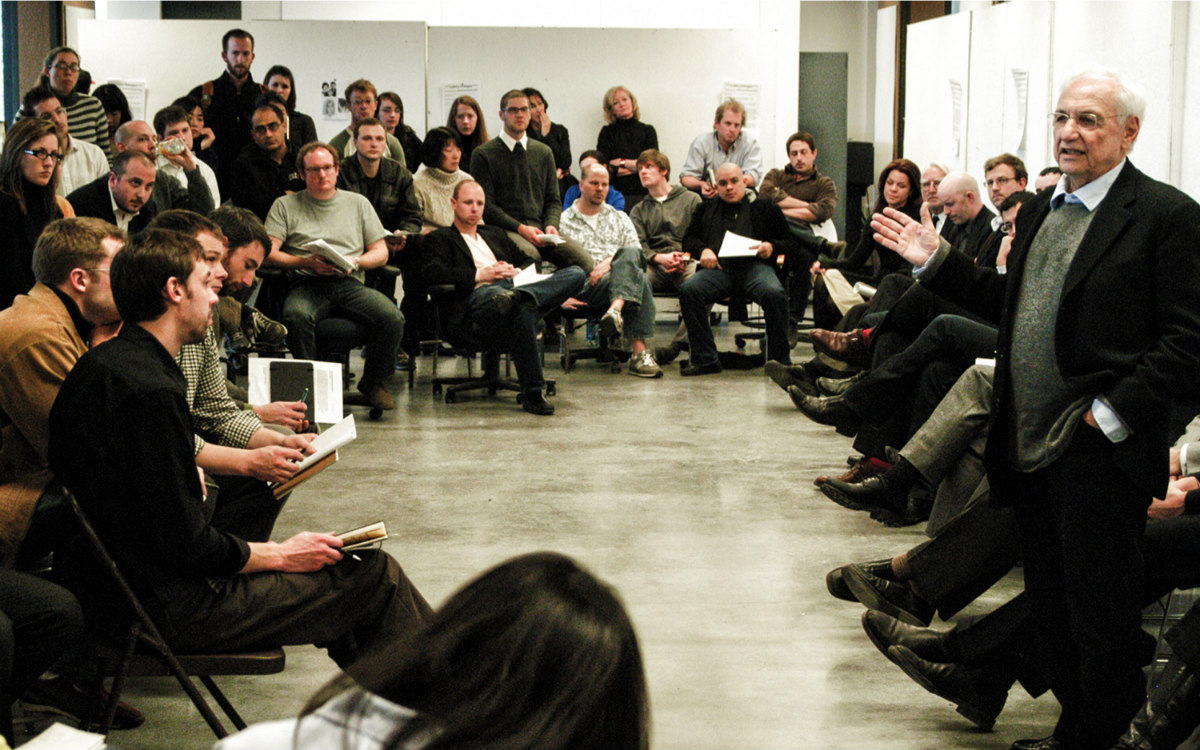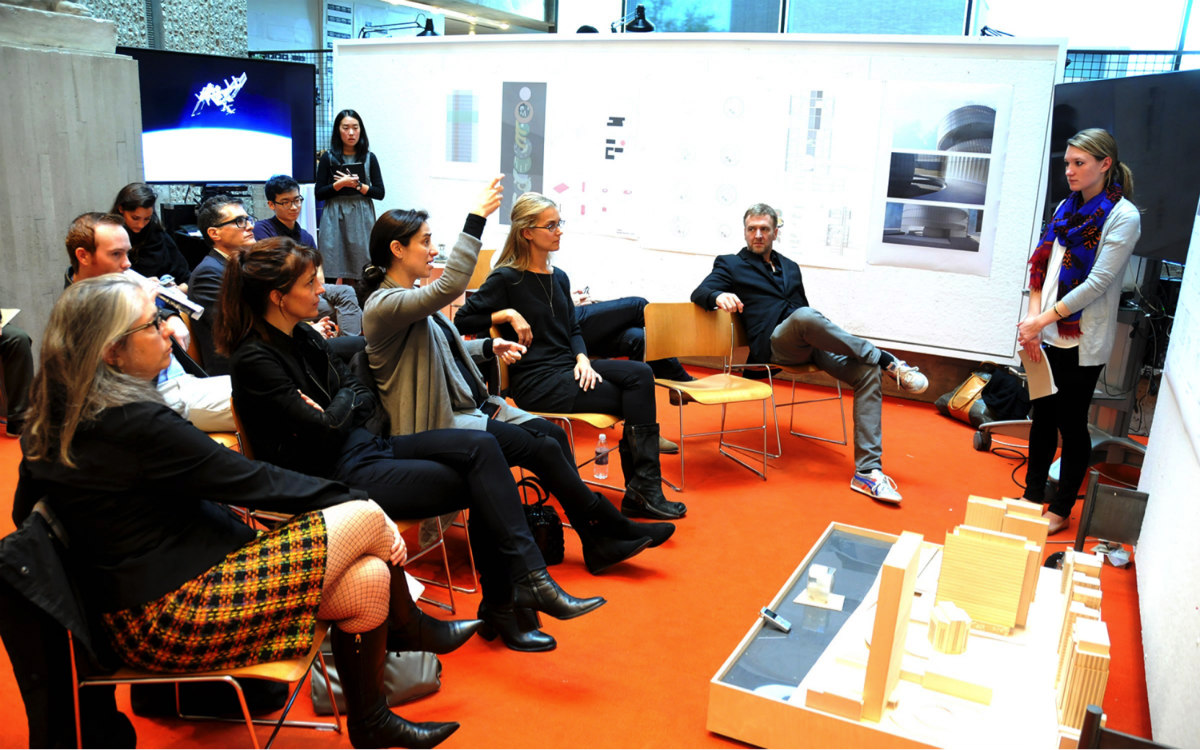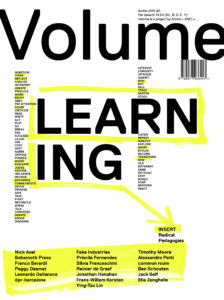I Will Learn You Architecture!

I remember my first job: Harbour Exchange, buildings 4, 5, 7 & 8, London Docklands, 1988. A building frenzy had engulfed London during the last years of Thatcher’s reign, allowing many recently graduated architects like myself a first taste of practice. The quality of the buildings we worked on, only ever referred to by their number, was bland – not quite the post-modern pastiche of Canary Wharf, but rather a dumbed down form of modernism: straightforward money making machines. They were commissioned under so-called Design and Build contracts, which meant we essentially worked for the contractor, for whom we produced on-demand drawings with no further say in how our work would be executed. My first task had been to amend the ceiling plans of the lower and upper ground floors of office buildings, which were still under construction. Suspended ceilings had to be redesigned to contain star-like lighting patterns and fixed points from which to hang the occasional chandelier. The investor had calculated that with retail uses on the ground floors (instead of offices), the buildings would generate substantially larger financial returns, and so a partial conversion was launched even before the buildings were finished. Among the staff of junior architects, there was a perverse delight in the thought that if we drew fast enough, the conversion of the building’s interior might work its way up and eventually overtake the ongoing construction of the upper floors.
I had graduated only six months earlier and in many ways my first job came as a complete shock. It was not so much the quality of the buildings I worked on that shocked me, or the gratuitous nature of decisions such as the above, but rather the fact that practicing as an architect appeared to have nothing, and I mean absolutely nothing to do with studying architecture. The first emotional state I recall as a practicing architect is that feeling of utter uselessness. My technical knowledge fell way short of what it needed to be, making me largely inadequate, and nobody was interested in the elevated philosophical considerations I had developed during my studies. For this job I was at the same time over- and under-qualified. It was an experience that I shared with other recent graduates. We kept our spirits up and tried to feel good about ourselves. Admittedly, we worked on garbage, but this was straightforward garbage. (At least we were not involved in the Cesar Pelli building being built next door.) Pay was good and working days were neatly confined 9 to 5’s. Still, in the face of a never-ending stream of seemingly pointless tasks, every day seemed to last a lifetime.
I was confident things would change with time. As soon as I would no longer have to execute the questionable design decisions made by others – in architecture they are that by definition – things would get better. Ultimately there would be room to put into practice some of the idealism I had developed in school. However, once I began working for myself, everything that had bothered me as an employee only presented itself in an exacerbated manner. This time there were mouths to feed. I quickly found that, in the face of economic needs, the architect is a largely powerless figure. Saying no, or questioning a client’s directives, is at best a matter of gentle persuasion, but never a battle of equals.
Many of my contemporaries resorted to teaching. Some did so fresh out of university. To me that seemed a strange career decision: a kind of pre-emptive and premature capitulation at the first sign of trouble. I also wondered what somebody barely having had a taste of the real world could possibly have to teach apart from what they themselves had been taught just a few years prior. The recycling of experience obtained from university in the context of a university seemed a strangely self-referential, somewhat incestuous process, which might help people to make it to graduation, but certainly not prepare them for a life beyond.
The creation of an educational bubble, even when invoked in the name of protecting academic integrity, seems a self-defeating purpose. In forever postponing and never confronting the shock of practice – god forbid we ever realize our own insignificance – it induces a strange state of schizophrenia. On the one hand the aspiring architect is encouraged to entertain almost megalomaniac ambitions, on the other he is left largely unprepared for the world upon which he projects this megalomania. I am not talking about a lack of technical or professional competence here, but rather about the ability to come to terms with a society wholly indifferent to his ideals. Once unleashed into the real world, the architect is perplexed by an utter lack of authority, stuck in a large gap between what he thinks should happen and what he ends up doing.

The more hermetic our schools, the more distant the realities of practice become. When practice is not engaged, it tends to become romanticized. In the context of architectural education, star architects have developed into virtual deity. (Sometimes the mere knowledge that you exist in the vicinity of one is enough for people to ask your autograph…) Still, star architects only account for a negligible portion of all that gets built. It is a weird delusion that, by having every architect aspire to that status, we can achieve even the tiniest improvement of the built environment as a whole. In the 1980s conservative policies in the US introduced the notion of trickle-down economics, in which catering to the super rich was ultimately thought to create a better situation for everybody. By cultivating a limited number of venerated architects as role models for an entire profession, we have created our own form of ‘trickle-down architecture’.
As a profession, architecture embodies a strange paradox. In economic terms it is a largely reactive discipline, a response to pre-formulated needs. In intellectual terms it is the opposite: a visionary domain that claims the future. In this capacity architecture aspires to set the agenda and precede needs. The unfortunate thing for architects is that both conditions are equally true, making architecture a curious form of omniscience practiced in a context of utter dependency. This also explains the often Rasputin-like nature of architect-client relationships. A former employer (shortly before firing me) once said: “the most important thing for an architect is to possess charisma!” It is only now, when writing this piece, that I understand the full significance of his statement. Charisma – probably best defined as the appearance to know something others don’t without ever revealing what – is critical because, like a state of hypnosis, it has the capacity to obscure established relations of power. It is precisely the incongruence between architecture’s intellectual claims and its economic reality that causes something as vague as charisma to be of such importance. It allows the architect to temporarily suspend the disbelief of his patrons and get the upper hand in the absence of a real mandate. Charisma is pure psychology – that which mediates between the scale of one’s ambitions and the limits of one’s power.
Do I wish my education had been different? Not really. What I do wish however, is for my education to have been candid about the status of what I was being taught, that some notion of context would have been provided… a side note to explain that what I was learning was actually a relatively marginal form of idealism entertained only by a small minority; that the considerations that went into the built environment were of an altogether different nature than the ones we were being taught. It is not that I would have made another choice, nor do I dislike my profession. However, with a little more information I would have at least known what I was in for. In hindsight I would have used the six years of relative intellectual freedom considerably differently from the way I did. I would have spent less time on studying the profession’s intricacies and more time on studying its context, would have embraced the vulgarity of the real world as the only way to ultimately overcome it, would have developed more entrepreneurial and fewer artistic interests and would not have wasted the better half of my time in awe of role models which in the present world do not allow for emulation. I would have recognised Le Corbusier and Mies for what they actually are: history.
The education of architects is a precarious phenomenon. To disclose too early the realities of practice would probably discourage even the staunchest optimist. It would kill the productive idealism that you inevitably need as an architect. On the other hand architecture needs a real knowledge of practice if it is to produce any meaningful critique of that same practice. Architecture learns from what it applies and applies what it learns. The education of an architect is a permanent chicken and egg situation, where theory and praxis, idealism and pragmatism, resistance and surrender become entangled in an inextricable web in which it is forever unclear what prevails. In the context of architecture and its education, there is a permanent and inescapable interference between the object of critique (praxis) and the critic (the architect), who is formed by and complicit in that which he critiques. The contemporary architect – the human typology produced by this education – is generally doomed to be a mistrusted idealist even before he has properly started practicing.

How can teaching architecture prepare for practice without itself degenerating into a form of practice? Architecture exists by virtue of a conceptual distance from the arena in which it ultimately operates, as a hard earned space to think before doing (not something any of us would be keen to give up). Education is the perfect period to cultivate and explore such a space. Yet, for that very reason it also becomes hard to leave education, because it invariably means leaving this contemplative space. One learns to think only to find out that outside there is no real time to think, that one is condemned to an infernal rat race to keep up with seemingly incoherent demands. Such precisely was the formative experience of my first acquaintance with practice in London’s Docklands: a confrontation between carefully cultivated convictions and an absolute lack of demand for them.
Can architecture education be reinvented? Can it stop being a way to suspend practice in the name of thinking, and instead become a way to turn practice itself into the object of thinking? Here again, I am not advocating any form of radical pragmatism or some sort of surrender, but simply an enlarged curiosity: an eagerness to obtain a form of general knowledge of the context and conditions in which architecture is produced and with which it somehow has to come to terms. Architecture is a pinball in a maze of considerations and interests of which architects are often the ones least aware. Subject to ulterior (largely financial) motives, architecture is a fundamentally different phenomenon than for which architects hold it. More than a means to provide space, buildings are vehicles for investment, an indispensable pillar of the current economic system and, as we have seen with the financial crisis of 2008, also a potential source of its instability. Ignorance of this mechanism coupled with a misplaced hubris creates a lethal cocktail, in which the architect inevitably becomes complicit in causes antithetical to the ones he claims to profess.
Only when architecture confronts its true status can it be properly taught as a discipline. Clearly that will come at a price, as it will require honesty about all the things architecture should not claim, or at least not claim exclusively. One of the most important things to acknowledge is that nobody needs an architect to build a building. When it comes to architecture’s supposed core business, architects have become largely unnecessary. Architecture creates through design what happens otherwise by default. Buildings will get built, with or without architects. Building is a largely self-perpetuating phenomenon: the assemblage of a limited number of standardized industrial products, subject to an in-house expertise of contractors themselves. System building as a methodical science was supposed to have died along with the former GDR. Still, that is exactly what has become the dominant mode of building worldwide. In terms of technical expertise, architects are typically outwitted by contractors and even by some of their more professional client teams. The continued insistence that the work of an architect is the only way to arrive at a building, with abundant evidence to the contrary, forces architecture into a humiliating routine of self-legitimization. The vast majority of the built environment is of an unspeakable ugliness and the profession of architecture has done little to change that. Architecture’s own track record should discourage its claims to exclusivity; in insisting on it, architecture only contributes to its own demise.
What then is the ‘added value’ of architecture? What becomes different once an architect is involved?
In my view, the real merit of architecture does not lie in that it creates any less ugliness, but that it is aware when it does. That there is some internal system of critique that always offers hope for improvement. Economic pressure notwithstanding, architects are still a community of peers. They still combine a healthy mix of competitiveness with a sincere appreciation for each other’s work. There is a shared sense of quality among architects even in the absence of an overall consensus about style. Whenever one of them rises to an exceptional level, his or her colleagues are generally able to recognize it. Furthermore, a healthy dose of peer pressure mostly discourages architects from engaging in causes beyond their conviction. When they do, they know their colleagues are watching over their shoulder.

The other big difference is that architecture cultivates a motive beyond money. That makes it an exception in the current economic framework. I would not go as far as to say that architecture is not motivated by money, but that there is another goal that ultimately overrides money. Architects do not trade their labor for money. In fact, it is often difficult to find any correlation between their efforts and the financial reward. There is hardly a discipline that has made (unpaid) overtime the standard procedure in the way architecture has. This doesn’t even so much happen at the request of clients, but rather through an almost religious belief on the part of the architects in the importance of their labor.
In the long run however, any such motivation (work over money) will only be sustainable once the logic of money is properly mastered. In general, the exposure of architects to money is limited to dealing with budget constraints. The other side of the building economy, that of financial returns, for most part remains obscured from the architect’s view. Yet, it is these sums that make any financial expenditure on construction, including architects’ fees (defined as a percentage of construction cost) pale into insignificance. Buildings are invariably built too cheaply and sold too expensively. If architects would be aware, it would not only radically alter the nature of their work, but it could also mark a fundamental shift in the economy of architecture firms themselves. With architects’ indemnity insurance premiums going through the roof, ignorance of money is rapidly becoming unaffordable.
Even if, in an extreme case, architecture’s motives were to be exclusively idealistic, it is important to realize that also idealism needs financing. (The early communists funded their revolutionary activities by robbing banks.) To overcome the banalities of the real world you need to know all about the real world. Architecture has long thought it could defeat the real world by cultivating a form of splendid isolation. Ultimately, that will not work. In order to beat the system, we first need to play the system. Only when we know how to play the system, can we play the system against itself. Currently, the system plays us.
When it comes to the education of architects, what I would propose is a reverse play between architecture and its context, a temporary state of emergency in our educational institutions, in which for a particular duration studying the context of architecture takes priority over studying architecture itself.
With context I mean anything from high-level political considerations to the mundane financial logic that goes into buildings – an understanding of any ulterior motive that, for better or for worse, affects our work. Exposed to almost every facet of this context, architecture is in a unique position to extract from it a type of knowledge that no other party can. In a landscape dominated by specialists, the architect offers a rare perspective: that of the generalist, the narrator who can translate even the most banal combination of subjects into a form of discourse. In the context of complex construction efforts, he or she is the mediator who synthesizes various and diverging interests into an integrated whole. It is generally the architect who ends up acting as the spokesperson, even if the technical and financial complexity of these efforts far exceeds his or her professional competence.

Despite the general absence of evidence to support its arguments, architecture manages to exert a strange authority. In fact, the more it is seen to abandon the whole notion of evidence, the stronger its position. Somehow it is able to mobilize a leap of faith against the perpetual inconclusiveness of numbers. It is this ability that may well be architecture’s prime asset (and perhaps therefore also what should be conveyed in an educational context). Architecture is an ancient discipline that appears to be in possession of a wisdom no one else has. Even at his most helpless moments, the architect’s autonomy is hardly in question. (Charisma helps.) Architecture is a unique combination of both sovereignty from- and surrender to those disciplines. It doesn’t need to be territorial, as its territory is everywhere and nowhere at the same time.
How should architecture use this power? When it comes to building, architecture is different from any other guest at the table. It is not one of the building disciplines, but rather a meta-discipline. It describes, theorizes and conceptualizes the very process in which it participates. It offers a possibility for a critique from within. It is informed by practice, yet in a position to turn its acquired insights against practice itself. Architecture offers space for contradiction. (Even in the context of this piece, I realize that I have contradicted myself at least five times.) As a consequence, architecture has the unique potential to become a disruptive force in the context of the self-perpetuating system that the production of the built environment has become. Architecture becomes a way of beating the system: bypassing supply and demand, cost and benefit, investment and return, LEED and BREEAM and all the other performance indicators which have come to dominate building practice. Almost by default architecture becomes political, a questioning of the ubiquitous, seemingly inescapable logic of the market economy. In a last instance, it is the mere possibility of an alternative that constitutes a political agenda, even when the specifics remain sketchy at best.
If architecture is to reclaim lost ground, it needs to accept its true nature. It should stop pretending to offer the same specialized expertise as the engineers, quantity surveyors, sustainability consultants and all the other supposed ‘experts’ that congregate around ever larger meeting tables (generally with a large hole in the middle) from which buildings now magically emerge. It should not engage in the tough talk. Only when we stop viewing architecture as a professional expertise on par with other building disciplines, can architecture be free to realize its full potential.
Arena, Blueprint, Platform, Framework, Theatre, Stage, Sphere, Structure, Façade, Base, Foundation, Model… The metaphors used to describe anything from organizational structures to corporate strategies and political agendas are proof of the ever-present conceptual force of architecture. Precisely at the moment when architecture seems wholly at the mercy of powers that be, its language is being used to articulate the constructs of those very powers. Even in the context of massive innovations in business and technology, architecture maintains a surprising degree of relevance. The thinking it has developed over centuries has enabled it to infiltrate other domains. In a final instance, that should also enable it to transcend its most important professional limitation: the obligation to produce buildings.
In the late nineties, the rediscovery of architecture as a primarily conceptual medium led to the formation of AMO. It was later applied in an educational context at Strelka. Our mission was to redefine architecture purely as a form of thinking, which could be applied to an array of subjects. Informed by the broadest possible context, it could in turn inform the broadest possible context. Apart from generating a number of interesting projects – projects which one might not immediately expect from architects – it has perhaps first and foremost allowed a progression of our own knowledge. We have become the students. With the formation of AMO, ten years after my first encounter with practicing architecture, working on- and learning from projects finally struck a balance: a catering to curiosities not felt since university, generating both a sense of engagement and personal progress.
‘I will learn you architecture’, Herman Hertzberger used to tell us as students at the Berlage Institute. In hindsight his bad English carries great profundity, a deep knowledge of the secret how knowledge of architecture is ultimately conveyed: a reciprocal process in which the question of who teaches whom is best forever deferred.

This article was published in Volume #45, ‘Learning’.